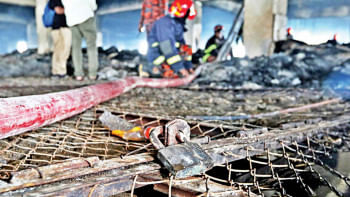Where’s the noose for 'murder caused by negligence'?

In 2021, the Nagarik Tadanta Committee (Citizens' Investigation Committee) looked into the Hashem Foods factory fire that tragically killed 54 workers and injured many others. They concluded that the fire was not just an accident but "murder caused by negligence."
The investigation found that the six-story building had no smoke detectors, fire alarms, or emergency exits. Additionally, watchdog agencies like the Department of Labour, the Department of Inspection for Factories and Establishments (DIFE), and the Fire Service and Civil Defence did not properly do their jobs. There were irregularities in how they granted various clearances from the beginning.
However, nearly two years later, in September 2023, the Criminal Investigation Department (CID) removed the names of the factory owner, Abul Hashem, and his four sons from the charge sheet. Inspector Moksedur Rahman, the investigating officer, said there was not enough evidence against them. Instead, the charge sheet included six other people, like the factory's Chief Executive Officer Shahan Shah Azad and several DIFE officials. This decision has led to calls for renewed legal action and further investigation to ensure justice for the victims and their families. The exclusion of the owner and his sons has caused outrage among victims' families and the public, who believe the factory owner should be held responsible for the poor safety measures that led to the disaster.
Why are the owners not facing consequences in the case? It's a crucial question, and the answer is not simple. These are not mere silos operating independently; the accused CEO did not act in isolation or solely out of personal volition. A CEO often comes into the picture well after the establishment of their factories. From the top down, it becomes painfully apparent: workers' safety was never the priority.
Under standard practices, before even laying the first brick, factory owners are required to navigate a labyrinth of bureaucratic approval. A business must first secure a trade license from the local municipality or city corporation. Next, they need to register with the Registrar of Joint Stock Companies and Firms (RJSC). Following that, an Environmental Clearance Certificate from the Department of Environment (DoE) is mandatory, necessitating either an Initial Environmental Examination (IEE) or an Environmental Impact Assessment (EIA), depending on the scope of the project. Furthermore, if the factory is to be situated in Dhaka, submission of the building plan to RAJUK, or the respective development authority, is required to ensure adherence to building codes and safety regulations.
The investigation exposed failures across multiple agencies. While the building lacked fire safety measures, the Bangladesh Fire Service and Civil Defence (BFSCD) seemingly cleared it anyway. The Department of Inspection for Factories and Establishments (DIFE), responsible for factory layouts and safety compliance, also appears to have dropped the ball. This lack of due diligence by all agencies involved eventually led to the death toll.
Unfortunately, this laxity might be widespread. Many of Bangladesh's 46,000 factories likely have questionable paperwork. Through bribery and manipulation, factory owners exploit a corrupt system, escaping accountability for their negligence, which in this case, tragically resulted in deaths. This "bhai-brother" culture within the system, where approvals can be bought, leaves workers in a horrific situation. They sign on for a secure future, but end up signing their own death warrant.
In this intricate pre-operational phase, each step theoretically serves as a safeguard, a testament to due diligence. Yet, when disaster strikes, the spotlight narrows on the executives, leaving the shadowy complicity of owners unexamined. Why?
What's more troubling is negligence is not just a problem in factories. In March 2024, a massive fire at the Green Cozy Cottage Shopping Mall on Dhaka's Bailey Road resulted in at least 45 deaths. The fire started in a restaurant and spread quickly due to gas cylinders placed in the building's corridors. Many victims suffocated or were hurt while trying to escape the blaze.
Similarly, in June 2022, a major fire at an inland container depot near Chattogram's Sitakunda area killed around 50 people, including 10 firefighters. The fire was worsened by improperly stored hydrogen peroxide, causing a series of explosions that took days to control. In 2019, a series of fires in Dhaka's Chawk Bazar area and a high-rise building resulted in nearly 100 deaths. The fire started in a warehouse, that stored highly flammable chemicals and then spread to multiple buildings.
These incidents are just the tip of the ice-berg among many incidents that have caused irreversible harm to citizens. And what they highlight are recurring issues — inadequate fire safety measures, such as the lack of emergency exits, poor storage of flammable materials, and substandard electrical wiring, which contribute to the high incidence of fatal fires in Bangladesh.
The frustration mounts as we keep hearing the same responses from our authorities. We've heard these empty promises of thorough investigations before. Which makes me think that perhaps it's the growing influence of the private sector, gaining dominance over the government since the 90s. And perhaps its cosy relationship weakens government oversight and accountability.
What the Bangladesh government usually does in such scenarios is amend a few laws without focusing on the capacity building of those relevant departments responsible for safeguarding. And as a result, on paper it always shows "something had been done". But has anything really changed in our present status quo?
After the Rana Plaza incident, the Ministry of Labour and Employment released a document highlighting the steps the government took. The first step was amending the Bangladesh Labour Act of 2006 on July 16, 2013, to improve workers' safety, welfare, and rights, while promoting trade unions and collective bargaining. This amendment involved changes to 76 sections and added 8 new ones, complemented by the adoption of the National Occupational Health and Safety Policy. Critics argue that these legislative changes, though comprehensive on paper, have not been sufficiently enforced, leading to continued safety violations in the industry.
After the amendment, trade union registration in the RMG sector gained momentum, with 351 new trade unions registered. The International Labour Organization (ILO) initiated training programs for union office bearers. While this is a positive step, the effectiveness of these unions is questionable, as they often face intimidation and resistance from factory owners, undermining their ability to advocate for workers' rights effectively.
New rules were published in the official gazette on September 15, 2015, containing 367 sections and seven appendices. These rules aim to strengthen regulatory compliance in the RMG sector. Despite this, enforcement remains inconsistent, and many factories still operate without adhering to these regulations, highlighting a gap between policy formulation and implementation.
I fear that negligence has become so rampant in our country that it has seeped into our behaviours. Many of us walked past those restaurant corridors on Bailey Road without fire safety measures, only to sigh and not report it perhaps because of the bureaucratic processes involved in the reporting. When citizens are perpetually pushed into survival mode, how can we expect any better from them? How can we expect them to stand up? Perhaps it's time to scrutinise the systemic flaws that allow those at the top to dissociate themselves from the operational realities of the factories they own.
Nazifa Raidah is a development practitioner. Previously she worked as a journalist at the Daily Star. Reach her at [email protected]
Views expressed in this article are the author's own.
Follow The Daily Star Opinion on Facebook for the latest opinions, commentaries and analyses by experts and professionals. To contribute your article or letter to The Daily Star Opinion, see our guidelines for submission.

 For all latest news, follow The Daily Star's Google News channel.
For all latest news, follow The Daily Star's Google News channel. 











Comments